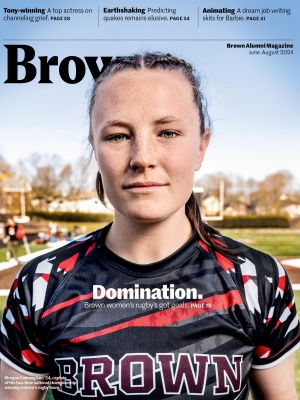Physics & Belonging
A Black mentor made the difference
This summer, Farrah Simpson ’21 ScM, ’24 PhD will become the first Black woman to earn a doctorate in physics from Brown. Her path to a PhD began in seventh grade, in her home country of Jamaica. Her engineer father enrolled her older siblings in an applied physics course, and Simpson eagerly tagged along. The instructor “would teach in a way that made everything that you learn connected with what’s around you,” she remembers. From the very start, she loved studying “something that felt so intuitive.”

Her interest persisted through high school, so she enrolled in an introductory physics course during her first semester at Columbia University. Her professor was a particle-physics expert who liked to go on tangents about high-energy experiments. Simpson—who had only ever studied applied physics—felt her curiosity ignite. “Oh, my gosh, I love this. I could see myself doing this for the rest of my life,” she thought. She started doing research on condensed matter experimentation, graduating with a physics degree in 2017.
Yet Simpson did not apply to PhD programs, choosing instead to teach science at a New York City middle school. During her first year of teaching, a friend connected her with Brown physics professor Stephon Alexander. Like Simpson, Alexander is Black and Caribbean.“That was the first time I met a Black physicist and it was kind of a turning point,” says Simpson. She realized that the main reason she hadn’t pursued a PhD was “not being able to see myself as a physicist.” She joined Brown’s doctoral program in 2018, excited to work with mentors like Alexander and the late Meenakshi Narain.
She says one of Alexander’s and Narain’s most useful teachings is that the ability to succeed in physics is not inborn. As a younger student, Simpson thought struggling with hard material meant she wasn’t cut out for physics. “Whenever I was doing other subjects, that’s not how I felt—I just felt like I need to practice, I need to study,” she says. “But when you think of physics, you’re like ‘oh it’s just really hard, it’s just something I can’t do’…a lot of physics is building the confidence.”
To that end, Simpson cofounded Brown’s chapter of the National Society of Black Physicists; she also served as president of the NSBP student board. For Black History Month, members lined the lobby of Barus & Holley with photos of Black physicists who made important contributions to the field. “Lots of people showed up,” she says. “It was a pivotal moment for our group.”
In addition to her success as a community-builder, Simpson stands out academically. Her dissertation centers around the search for a particle called X5/3 which would help explain discrepancies in the standard model of particle physics. In 2022, Simpson was one of two graduate students selected for a fellowship at Fermilab’s Large Hadron Collider. There, she learned new ways to test parts of a particle detector called the Compact Muon Solenoid (CMS). Together with postdoc Jingyu Luo, she brought the novel testing methods to Brown. Now Brown physicists can use those techniques to test CMS parts on the seventh floor of Barus & Holley.
Simpson’s next destination is Princeton, where she’ll serve as a Dicke Fellow. Coincidentally, the CMS hardware she’s been testing at Brown is also tested on Princeton’s campus. Simpson might think she’s leaving Brown physics—but traces of the department will be following her.





